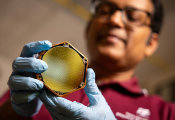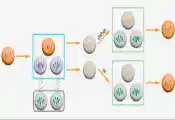Manipulating the Geometry of 'Electron Universe' in Magnets
Researchers at Tohoku University and the Japan Atomic Energy Agency have developed fundamental experiments and theories to manipulate the geometry of the 'electron universe,' which describes the structure of electronic quantum states in a manner mathematically similar to the actual universe, within a magnetic material under ambient conditions.
The investigated geometric property - i.e., the quantum metric - was detected as an electric signal distinct from ordinary electrical conduction. This breakthrough reveals the fundamental quantum science of electrons and paves the way for designing innovative spintronic devices utilizing the unconventional conduction emerging from the quantum metric.
Details were published in the journal Nature Physics on April 22, 2024.
Electric conduction, which is crucial for many devices, follows Ohm's law: a current responds proportionally to applied voltage. But to realize new devices, scientists have had to find a means to go beyond this law. Here is where quantum mechanics come in. A unique quantum geometry known as the quantum metric can generate non-Ohmic conduction. This quantum metric is a property inherent to the material itself, suggesting that it's a fundamental characteristic of the material's quantum structure.
The term 'quantum metric' draws its inspiration from the 'metric' concept in general relativity, which explains how the geometry of the universe distorts under the influence of intense gravitational forces, such as those around black holes. Similarly, in the pursuit of designing non-Ohmic conduction within materials, comprehending and harnessing the quantum metric becomes imperative. This metric delineates the geometry of the 'electron universe,' analogous to the physical universe. Specifically, the challenge lies in manipulating the quantum-metric structure within a single device and discerning its impact on electrical conduction at room temperature.
The research team reported successful manipulation of the quantum-metric structure at room temperature in a thin-film heterostructure comprising an exotic magnet, Mn3Sn, and a heavy metal, Pt. Mn3Sn exhibits essential magnetic texture when adjacent to Pt, which is drastically modulated by an applied magnetic field. They detected and magnetically controlled a non-Ohmic conduction termed the second-order Hall effect, where voltage responds orthogonally and quadratically to the applied electric current. Through theoretical modeling, they confirmed that the observations can be exclusively described by the quantum metric.
"Our second-order Hall effect arises from the quantum-metric structure that couples with the specific magnetic texture at the Mn3Sn/Pt interface. Hence, we can flexibly manipulate the quantum metric by modifying the magnetic structure of the material through spintronic approaches and verify such manipulation in the magnetic control of the second-order Hall effect," explained Jiahao Han, the lead author of this study.

The main contributor to the theoretical analysis, Yasufumi Araki, added, "Theoretical predictions posit the quantum metric as a fundamental concept that connects the material properties measured in experiments to the geometric structures studied in mathematical physics. However, confirming its evidence in experiments has remained challenging. I hope that our experimental approach to accessing the quantum metric will advance such theoretical studies."
Principal investigator Shunsuke Fukami further added, "Until now, the quantum metric has been believed to be inherent and uncontrollable, much like the universe, but we now need to change this perception. Our findings, particularly the flexible control at room temperature, may offer new opportunities to develop functional devices such as rectifiers and detectors in the future."




































